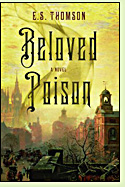Beloved Poison
by Elaine Thomson
by by
reviewed by Margaret Tomlinson

First in a planned series, Beloved Poison is narrated by a young apothecary with a secret
which is revealed to readers in the opening pages (I'll try not to spoil the surprise).
Jem Flockhart works at London's St. Saviour's Infirmary in the 1850s, an aging
medical institution scheduled for demolition to make way for a railway bridge. If
the staff resent this government decision, it's nevertheless clear St.
Saviour's is in dire need of rebuilding, preferably in a less damp location.
The buildings are crumbling; odors of graveyard, sewer and sickness pervade the
site; and the recovery rate of surgery patients is abysmal.
Jem reluctantly befriends Will Quartermain, a lowly junior architect who arrives to organize and empty the graveyard so the railway bridge will not be constructed on top of the dead. A discovery the two make together in one of the decaying buildings leads to a rash of murders, which may be related to the long-ago death of Jem's mother. Meanwhile, Jem's father is suffering from an unknown progressive disease that exhausts him and requires Jem to take over most of his responsibilities in the apothecary shop.
Beloved Poison vividly portrays the sad state of mid-nineteenth-century medicine. Though readers with sensitive stomachs may be disgusted by some of the descriptions, these are all too representative of a transitional stage when anatomy - thanks to a recent era's illicit dissections of bodies stolen from graveyards - was fairly well understood, but when germ theory was still in its infancy. Jem practices herbal medicine and reminds us that poisonous plants can be therapeutic in small doses, but also compounds such alarming prescriptions as "blue pills," composed largely of mercury and rose petals, and used for complaints ranging from syphilis to depression. Jem makes a sympathetic narrator, and the mystery is puzzling enough to keep readers entertained. If some suspension of disbelief is required (mostly relating to Jem's secret), the novel has enough strengths that most readers will be willing to overlook this. (2016, 390 pages)
More about Beloved Poison at Amazon.comOther mysteries relating to nineteenth-century medicine
A Sudden, Fearful Death by Anne Perry (1993), about a police inspector with amnesia and a nurse who helps him investigate the death of a nurse who had served with Florence Nightingale in the Crimea. More info
Race for the Dying by Steven F. Havill (2009), about a young doctor who takes a job in a Washington State logging town in 1891. See review or more info at Amazon.com
Ship Fever by Andrea Barrett (1996), a short story collection that includes the novella Ship Fever about a volunteer physician during a typhus epidemic among Irish immigrants to Canada fleeing review or more info at Amazon.com
Nonfiction about nineteenth-century medicine:
The Age of Miracles: Medicine and Surgery in the Nineteenth-Century by Guy Williams (1981). More info
The Western Medical Tradition by W.F. Bynum, et al. (2006). More info
Dying for Victorian Medicine: English Anatomy and its Trade in the Dead Poor, c. 1834-1929 by Elizabeth T. Hurren (2012). More info
Online:
St. Savior's Southwark, historic and present-day pictures of the site that seems to have inspired the novel.
Back to Directory of Book Reviews
Back to Novels of Nineteenth-Century Europe